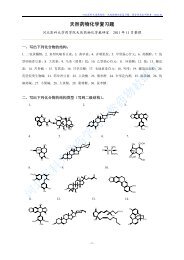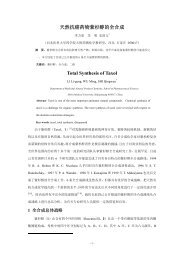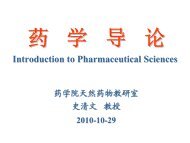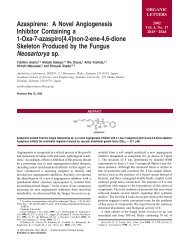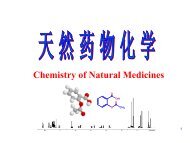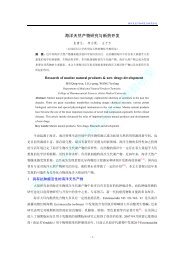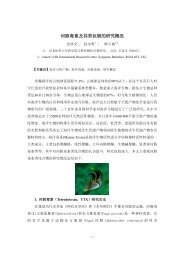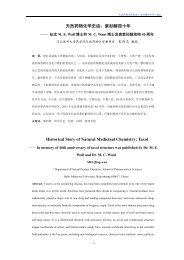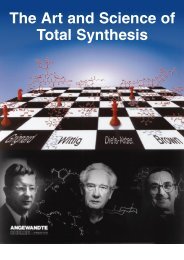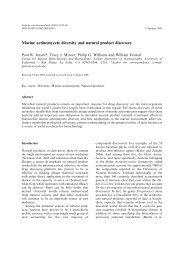Total Synthesis Highlights
Total Synthesis Highlights
Total Synthesis Highlights
Create successful ePaper yourself
Turn your PDF publications into a flip-book with our unique Google optimized e-Paper software.
The dipolar cycloadddition established the requisite stereochemical relationship between the three<br />
contiguous quaternary stereogenic centers of 1. It remained to adjust the functional groups around<br />
the newly-formed carbocyclic ring. Exposure to BF 3 .OEt 2 led to ring opening, followed by<br />
trapping of the intermediate carbocation with the t-butyl ester to give the lactone 13, with<br />
concommitant loss of isobutylene. Hydrolysis and decarboxylation gave the alcohol 14, the acetate<br />
of which was removed by reduction with SmI 2 . The derived enol triflate 15 was reduced to the<br />
alkene, which was deoxygenated by way of the thiolactam 16.<br />
The intramolecular dipolar cycloaddition exemplified by the conversion of 12 to 2 is a specific<br />
representative of a general and powerful approach to indole alkaloids, based on cycloaddition of<br />
an intermediate indole to a dipole or a diene. For more recent work along these lines by Professor<br />
Padwa, see Org. Lett. 2007, 9, 279, and Tetrahedron 2007, 63, 5962,<br />
45. The Overman <strong>Synthesis</strong> of (-)-Sarain A<br />
Larry E. Overman of the University of California, Irvine has recently (Angew. Chem. Int. Ed. 2006,<br />
45, 2912. ) described the first total synthesis of the antibiotic and antitumor alkaloid (-)-sarain A<br />
(3). The structure of 3 is particularly challenging, with two tertiary amines, one of them attached<br />
to a quaternary center. Note that although sarain A is drawn as the amino aldehyde, in fact the<br />
aldehyde and the proximal amine interact to form zwitterionic species that are difficult to purify.<br />
A key transformation in the assembly of 3 was the intramolecular Mannich cyclization of 1 to 2.<br />
This C-C bond forming reaction established the single carbocyclic ring of 3, while at the same<br />
time constructing with high diastereocontrol the tetraalkylated quaternary center.<br />
The enantiospecific preparation of 1 began with diethyl tartrate 4. The enolate of the derived<br />
oxazoline 5 added with high diastereocontrol to the Z-α,β-unsaturated ester 6 to give 7. The diester<br />
7 included the three continguous stereogenic centers of 8. The details of the conversion of 7 to the<br />
hemiaminal 8 had previously been reported by Professor Overman (J. Org. Chem. 1998, 63,<br />
8096, ; Tetrahedron Lett. 1999, 40, 1273, ; Org. Lett. 2005, 7, 933, ).



